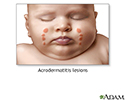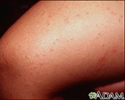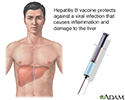Acrodermatitis
Papular acrodermatitis of childhood; Gianotti-Crosti syndrome; Acrodermatitis - infantile lichenoid; Acrodermatitis - papular infantile; Papulovesicular acro-located syndrome
Acrodermatitis is a childhood skin condition that may be accompanied by mild symptoms of fever and malaise . It may also be associated with hepatitis B and other viral infections.
Fever
Fever is the temporary increase in the body's temperature in response to a disease or illness. A child has a fever when the temperature is at or abov...

Malaise
Malaise is a general feeling of discomfort, illness, or lack of well-being.
Causes
Health care providers do not know the exact cause of acrodermatitis. But, they do know that it is linked with other infections.
In Italian children, acrodermatitis is seen frequently with hepatitis B . But this link is rarely seen in the United States. Epstein-Barr virus (EBV, mononucleosis) is the virus most often associated with acrodermatitis.
Hepatitis B
Hepatitis B is irritation and swelling (inflammation) of the liver due to infection with the hepatitis B virus (HBV). Other types of viral hepatitis ...

Other associated viruses include:
-
Cytomegalovirus
Cytomegalovirus
Cytomegalovirus (CMV) infection is a disease caused by a type of herpes virus.
 ImageRead Article Now Book Mark Article
ImageRead Article Now Book Mark Article - Coxsackie viruses
- Parainfluenza virus
-
Respiratory syncytial virus (
RSV
)
RSV
Respiratory syncytial virus (RSV) is a very common virus that leads to mild, cold-like symptoms in adults and older healthy children. It can be more...
 ImageRead Article Now Book Mark Article
ImageRead Article Now Book Mark Article - Some types of live virus vaccines
Symptoms
Skin symptoms may include any of the following:
- Rash or patch on skin
- Brownish-red or copper-colored patch that is firm and flat on top
- String of bumps may appear in a line
- Generally not itchy
- Rash looks the same on both sides of the body
- Rash may appear on the palms and soles. It does not occur on the back, chest, or belly area (this is one of the ways it is identified, by the absence of the rash from the trunk of the body).
Other symptoms that may appear include:
-
Swollen abdomen
Swollen abdomen
A swollen abdomen is when your belly area is bigger than usual.
Read Article Now Book Mark Article -
Swollen lymph nodes
Swollen lymph nodes
Lymph nodes are present throughout your body. They are an important part of your immune system. Lymph nodes help your body recognize and fight germ...
 ImageRead Article Now Book Mark Article
ImageRead Article Now Book Mark Article - Tender lymph nodes
Exams and Tests
The provider can diagnose this condition by looking at the skin and rash. The liver, spleen, and lymph nodes may be swollen.
The following tests may be done to confirm the diagnosis or rule out other conditions:
-
Bilirubin
level
Bilirubin
The bilirubin blood test measures the level of bilirubin in the blood. Bilirubin is a yellowish pigment found in bile, a fluid made by the liver. Bi...
 ImageRead Article Now Book Mark Article
ImageRead Article Now Book Mark Article -
Hepatitis virus serology
or
hepatitis B surface antigen
Hepatitis virus serology
The hepatitis virus panel is a series of blood tests used to detect current or past infection by hepatitis A, hepatitis B, or hepatitis C. It can sc...
 ImageRead Article Now Book Mark Article
ImageRead Article Now Book Mark ArticleHepatitis B surface antigen
The hepatitis virus panel is a series of blood tests used to detect current or past infection by hepatitis A, hepatitis B, or hepatitis C. It can sc...
 ImageRead Article Now Book Mark Article
ImageRead Article Now Book Mark Article -
Liver enzymes (
liver function tests
)
Liver function tests
Liver function tests are common tests that are used to see how well the liver is working. Tests include:AlbuminAlpha-1 antitrypsin Alkaline phosph...
 ImageRead Article Now Book Mark Article
ImageRead Article Now Book Mark Article -
Screening for
EBV antibodies
EBV antibodies
Epstein-Barr virus antibody test is a blood test to detect antibodies to the Epstein-Barr virus (EBV).
 ImageRead Article Now Book Mark Article
ImageRead Article Now Book Mark Article -
Skin biopsy
Skin biopsy
A skin lesion biopsy is when a small amount of skin is removed so it can be examined. The skin is tested to look for skin conditions or diseases. A...
 ImageRead Article Now Book Mark Article
ImageRead Article Now Book Mark Article
Treatment
Acrodermatitis by itself is not treated. Infections linked with this condition, such as hepatitis B and Epstein-Barr, are treated. Cortisone creams and oral antihistamines may help with itching and irritation.
Outlook (Prognosis)
Acrodermatitis usually disappears on its own without treatment or complication. Associated conditions must be watched carefully.
Possible Complications
Complications occur as a result of associated conditions, rather than as a result of acrodermatitis.
When to Contact a Medical Professional
Call your provider if your child has signs of this condition.
References
Cherry JD. Cutaneous manifestations of systemic infections. In: Cherry JD, Harrison GJ, Kaplan SL, Steinbach WJ, Hotez PJ, eds. Feigin and Cherry's Textbook of Pediatric Infectious Diseases . 7th ed. Philadelphia, PA: Elsevier Saunders; 2014:chap 58.
Gelmetti C. Gianotti-Crosti syndrome. In: Lebwohl MG, Heymann WR, Berth-Jones J, Coulson I, eds. Treatment of Skin Disease: Comprehensive Therapeutic Strategies . 4th ed. Philadelphia, PA: Elsevier Saunders; 2014:chap 88.
-
Acrodermatitis - illustration
Acrodermatitis enteropathica is a skin condition peculiar to children that may be accompanied by mild symptoms of fever and malaise. It may also be associated with hepatitis B infection or other viral infections. The lesions appear as small coppery-red, flat-topped firm papules that appear in crops and sometime in long linear strings, often symmetric.
Acrodermatitis
illustration
-
Gianotti-Crosti syndrome on the leg - illustration
Gianotti-Crosti disease is also called acrodermatitis of childhood. These red, elevated lesions do not contain pus and can occur on the limbs, buttocks, face, and neck.
Gianotti-Crosti syndrome on the leg
illustration
-
Hepatitis B - illustration
The hepatitis B vaccine is recommended for healthcare workers, people who live with someone with hepatitis B, and others at higher risk. The hepatitis B virus can damage liver cells. Immunization is also recommended for all infants and unvaccinated adolescents.
Hepatitis B
illustration
-
Acrodermatitis - illustration
Acrodermatitis enteropathica is a skin condition peculiar to children that may be accompanied by mild symptoms of fever and malaise. It may also be associated with hepatitis B infection or other viral infections. The lesions appear as small coppery-red, flat-topped firm papules that appear in crops and sometime in long linear strings, often symmetric.
Acrodermatitis
illustration
-
Gianotti-Crosti syndrome on the leg - illustration
Gianotti-Crosti disease is also called acrodermatitis of childhood. These red, elevated lesions do not contain pus and can occur on the limbs, buttocks, face, and neck.
Gianotti-Crosti syndrome on the leg
illustration
-
Hepatitis B - illustration
The hepatitis B vaccine is recommended for healthcare workers, people who live with someone with hepatitis B, and others at higher risk. The hepatitis B virus can damage liver cells. Immunization is also recommended for all infants and unvaccinated adolescents.
Hepatitis B
illustration
Review Date: 4/14/2015
Reviewed By: Kevin Berman, MD, PhD, Atlanta Center for Dermatologic Disease, Atlanta, GA. Review provided by VeriMed Healthcare Network. Also reviewed by David Zieve, MD, MHA, Isla Ogilvie, PhD, and the A.D.A.M. Editorial team.



